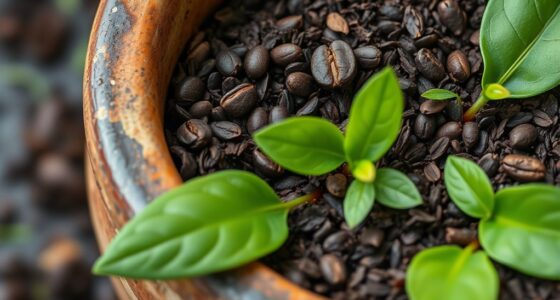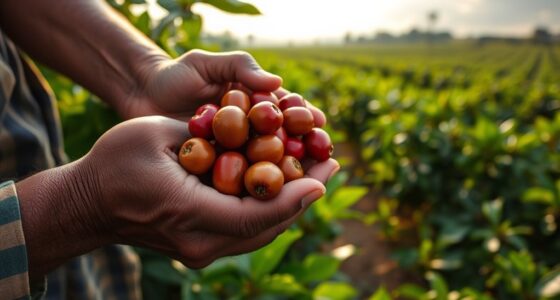Bird-friendly certification recognizes your landscaping practices that support local bird populations by emphasizing native plants, safe design, and habitat preservation. It encourages planting native trees and shrubs, creating migration corridors, and reducing hazards like window strikes and outdoor predators. This certification helps you become a steward of biodiversity, benefiting bird survival and ecosystem health. To find out how you can make your property more bird-friendly and contribute to conservation efforts, keep exploring these ideas further.
Key Takeaways
- Bird-Friendly Certification recognizes landscaping practices that support local bird populations and their habitats.
- It emphasizes planting native trees and shrubs to provide food, nesting sites, and habitat diversity.
- The certification promotes creating safe migration corridors and reducing hazards like window strikes and predators.
- It encourages design features that minimize disorientation and support healthy bird migration and survival.
- Certification fosters environmental stewardship, enhancing biodiversity and ecological health on properties of all sizes.

Bird-Friendly Certification is a program designed to recognize and promote landscaping practices that protect and support local bird populations. When you pursue this certification, you’re actively contributing to the preservation of essential bird habitats and helping create safe migration corridors. These corridors are critical pathways that allow birds to travel between breeding and wintering grounds, often crossing urban and suburban areas. By designing your landscape with bird conservation in mind, you make it easier for migrating birds to find food, shelter, and safe resting spots during their long journeys.
Achieving bird-friendly status means you consider how your land use impacts local wildlife. You’ll learn ways to plant native trees and shrubs, which provide natural food sources and nesting sites. Native plants are indispensable because they attract insects birds feed on and support a thriving ecosystem. When you incorporate these plants into your yard or community space, you’re creating a rich bird habitat that offers more than just aesthetic appeal—you’re making a tangible difference in the survival of local bird species.
Another key aspect of bird-friendly landscaping is guaranteeing that your property serves as an essential stopover for migrating birds. Migration corridors are often threatened by development and habitat fragmentation, which can leave birds without safe places to rest and refuel. By maintaining open, shrub-lined borders and avoiding excessive lighting at night, you help reduce disorientation and hazards for these travelers. Your efforts can help guarantee that migrating birds have access to safe pathways and critical resources, which can greatly improve their chances of successful migration.
The certification process also encourages you to eliminate hazards like window strikes and predation risks. Installing bird-safe glass or decals can prevent deadly collisions, while managing outdoor cats and other predators keeps bird populations safe. These small but important steps directly support the health of bird populations in your area, especially along essential migration corridors. Incorporating wildlife-friendly design principles into your landscape can further enhance habitat quality and safety for birds.
Ultimately, earning bird-friendly certification means you’re more than just a landscape owner—you’re a steward of local biodiversity. Your efforts help sustain bird habitat and migration corridors, ensuring that these species continue to thrive despite increasing urbanization. It’s a practical way to make your property a haven for birds while enhancing its beauty and ecological value. Whether you own a small garden or manage a large property, adopting bird-friendly practices aligns with a shared responsibility to protect our feathered neighbors now and into the future.
Frequently Asked Questions
How Does Bird-Friendly Certification Impact Local Bird Populations?
Bird-friendly certification positively impacts local bird populations by promoting urban habitat improvements and reducing hazards. When you support certified spaces, you’re helping create safe areas that protect migratory patterns and provide essential resources. These certified environments encourage nesting and feeding, which sustain diverse bird species. Your involvement helps maintain healthy bird populations, ensuring they thrive amidst urban settings and continue their crucial migratory journeys with fewer threats.
Can Private Homeowners Apply for Bird-Friendly Certification?
Applying for bird-friendly certification is like planting seeds for a better environment—you can do it as a private homeowner. Homeowner participation is encouraged, and certification eligibility typically includes meeting specific bird-safe habitat and building standards. If you’re committed to creating a space that supports local bird populations, you can certainly apply, helping to protect and nurture these creatures while also enhancing your property’s beauty and ecological value.
What Are the Main Challenges in Implementing Certification Standards?
You’ll face challenges in implementing certification standards, especially in urban habitats where space and resources are limited. Meeting certification criteria requires careful planning and adaptation to diverse environments. Ensuring consistent application across various settings is tough, and there’s often resistance from stakeholders unfamiliar with the benefits. Balancing ecological goals with practical constraints makes it difficult to establish universally accepted standards, but with collaboration, progress is achievable.
Is Bird-Friendly Certification Recognized Internationally?
Yes, bird-friendly certification is gaining international recognition, especially as awareness of bird migration and urban habitats grows. You might be surprised to learn how many countries are adopting these standards to protect migratory species and enhance urban environments. This global shift reflects a shared commitment to conservation. As you support certified spaces, you’re helping to create safer routes for migrating birds and healthier urban habitats worldwide.
How Often Must Certified Sites Undergo Renewal or Reassessment?
You need to renew your bird-friendly certification every three years. During this period, your site must undergo a reassessment process to guarantee ongoing compliance with certification standards. This renewal frequency helps maintain high standards and supports continuous habitat protection. Regular reassessment ensures your site continues to meet bird-friendly criteria, demonstrating your commitment. Staying up-to-date with this process keeps your certification valid and shows your dedication to preserving bird habitats effectively.
Conclusion
By choosing Bird-Friendly Certified products, you’re not just making a simple purchase — you’re opening a door to protect delicate ecosystems and give birds a fighting chance. Think of your action as a tiny ripple in a vast pond, eventually reaching shores unseen. Remember, every small step counts in the grand symphony of nature; your choices compose a melody of hope for our feathered friends. Together, we can turn the tide and ensure their songs continue to fill our world.









